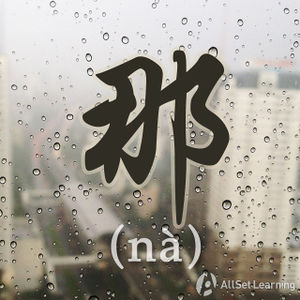Difference between revisions of "Measure words with "this" and "that""
m (Text replace - "{{#seo:keywords={{SEO Keywords}}}}" to " ") |
m (Text replacement - "{{HSK|HSK2}}" to "{{HSK|HSK2}}{{2021-HSK|HSK2}}") |
||
| (34 intermediate revisions by 13 users not shown) | |||
| Line 1: | Line 1: | ||
{{Grammar Box}} | {{Grammar Box}} | ||
| − | + | In English, when you refer to "this table" or "that girl" you only need two words: "this" or "that" plus the noun you're referring to. In Chinese, though, you also need a [[measure word]] in the middle between the two. In the very beginning you can get away with using [[Measure_word_%22ge%22|个 (gè)]] for everything, but pretty soon you're going to have to start using other measure words in these simple phrases. | |
| − | In English, when you refer to " | ||
== Structure == | == Structure == | ||
| − | If you use 这 (zhè) or 那 (nà) before a noun, you need to include a [[measure word]] | + | If you use 这 (zhè) or 那 (nà) before a noun, you also need to include a [[measure word]] before the noun. |
<div class="jiegou"> | <div class="jiegou"> | ||
| − | 这 / 那 + | + | 这 / 那 + Measure Word + Noun |
</div> | </div> | ||
== Examples == | == Examples == | ||
| + | |||
| + | Note: In this usage, the tone of 个 (gè) tends to soften, so it's represented below as a neutral tone. | ||
<div class="liju"> | <div class="liju"> | ||
| − | * <em>那</em> 个 人 <span class="trans">that person</span> | + | * <em>那</em> <strong>个</strong> 人 <span class="pinyin"> <em>nà</em><strong>ge</strong> rén</span><span class="trans">that person</span> |
| − | * <em>这</em> | + | * <em>这</em> <strong>本</strong> 书 <span class="pinyin"> <em>zhè</em> <strong>běn</strong> shū</span><span class="trans">this book</span> |
| − | * <em>那</em> | + | * <em>那</em> <strong>件</strong> 事 <span class="pinyin"> <em>nà</em> <strong>jiàn</strong> shì</span><span class="trans">that matter (in the sense of business, affair, or thing)</span> |
| − | * <em>这</em> | + | * <em>这</em> <strong>瓶</strong> 啤酒 <span class="pinyin"> <em>zhè</em> <strong>píng</strong> píjiǔ</span><span class="trans">this bottle of beer</span> |
| − | + | * <em>那</em> <strong>个</strong> 房间 <span class="pinyin"> <em>nà</em><strong>ge</strong> fángjiān</span><span class="trans">that room</span> | |
| − | * <em> | + | * <em>那</em> <strong>台</strong> 电脑 <span class="pinyin"> <em>nà</em> <strong>tái</strong> diànnǎo</span><span class="trans">that new computer</span> |
| − | * <em> | + | * <em>这</em> <strong>只</strong> 猫 <span class="pinyin"> <em>zhè</em> <strong>zhī</strong> māo</span><span class="trans">that cat</span> |
| − | * <em> | + | * <em>那</em> <strong>条</strong> 河 <span class="pinyin"> <em>nà</em> <strong>tiáo</strong> hé </span><span class="trans">that river</span> |
| − | * <em>那</em> | + | * <em>这</em> <strong>件</strong> 衣服 <span class="pinyin"><em>zhè</em> <strong>jiàn</strong> yīfu </span><span class="trans">this piece of clothing</span> |
| − | * <em> | ||
</div> | </div> | ||
| + | |||
| + | Although we didn't get into it here, the same pattern holds true when you use 哪 (nǎ) to ask "which?" | ||
==See also== | ==See also== | ||
| Line 41: | Line 43: | ||
=== Books === | === Books === | ||
| − | + | {{Source|Basic Patterns of Chinese Grammar|33}} | |
[[Category:A2 grammar points]] | [[Category:A2 grammar points]] | ||
| + | {{HSK|HSK2}}{{2021-HSK|HSK2}} | ||
[[Category:Measure words]] | [[Category:Measure words]] | ||
| − | {{Basic Grammar|这|A2|这 / 那 + | + | {{Basic Grammar|这|A2|这 / 那 + Measure Word (+ Noun)|那 <em>个</em> 人。这 <em>杯</em> 水。|grammar point|ASGZC42B}} |
{{Rel char|那}} | {{Rel char|那}} | ||
{{Similar|"Some" Using "yixie"}} | {{Similar|"Some" Using "yixie"}} | ||
Latest revision as of 08:57, 21 April 2021
-
Level
-
Similar to
-
Used for
-
Keywords
In English, when you refer to "this table" or "that girl" you only need two words: "this" or "that" plus the noun you're referring to. In Chinese, though, you also need a measure word in the middle between the two. In the very beginning you can get away with using 个 (gè) for everything, but pretty soon you're going to have to start using other measure words in these simple phrases.
Structure
If you use 这 (zhè) or 那 (nà) before a noun, you also need to include a measure word before the noun.
这 / 那 + Measure Word + Noun
Examples
Note: In this usage, the tone of 个 (gè) tends to soften, so it's represented below as a neutral tone.
- 那 个 人 that person
- 这 本 书 this book
- 那 件 事 that matter (in the sense of business, affair, or thing)
- 这 瓶 啤酒 this bottle of beer
- 那 个 房间 that room
- 那 台 电脑 that new computer
- 这 只 猫 that cat
- 那 条 河 that river
- 这 件 衣服 this piece of clothing
Although we didn't get into it here, the same pattern holds true when you use 哪 (nǎ) to ask "which?"



